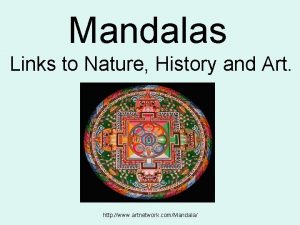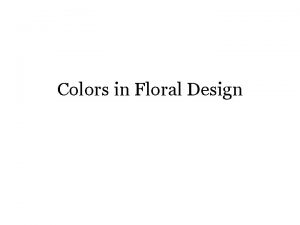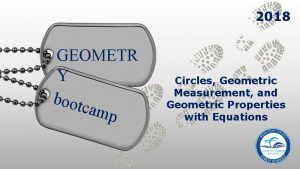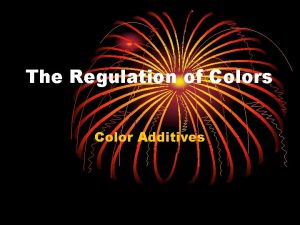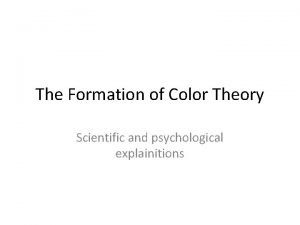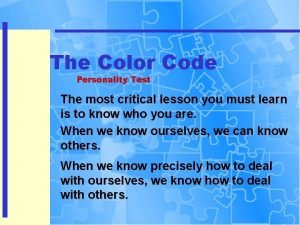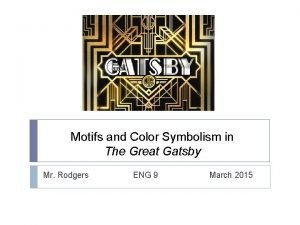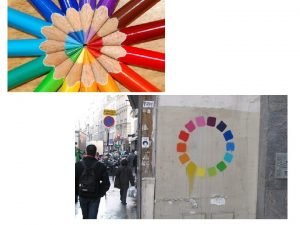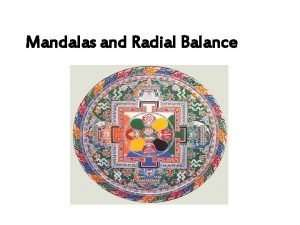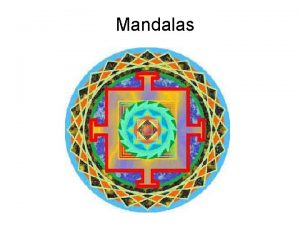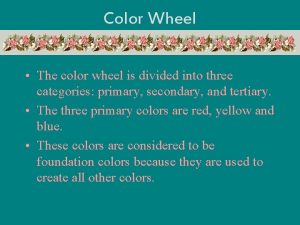Color Wheel Mandalas Mandala A geometric design intended






















- Slides: 22

Color Wheel Mandalas

Mandala • A geometric design intended to symbolize the universe. • Originally used in Buddhist and Hindu practices. • Manda-essence • La-container • Symbolizes the mind and body of the Buddha.

• The origin of the mandala is the center; a dot. It is free of dimensions and a gathering for energies to draw toward. • It represents outer and inner spaces. • The line, which is created by the dot, creates triangular shapes for the geometric patterns to develop. • Monks work together to complete the mandala.

• Each monk is assigned a section to complete. • The monks continue to work on one section at a time to ensure that one portion of the mandala does not get completed before another. • The perfect square shape represents the absolute space of wisdom. • Each space represents; loving kindness, compassion, sympathy, and equanimity.

Peaceful Dieties • • • Compassion Wisdom Courage Strength Quest for sacred knowledge

Wrathful Dieties • Struggles in overcoming one’s own alienation. • Inner inflictions that darken our thoughts, words, and deeds. • Fearful only to those who perceive them as such.

Masculine and Feminine • Male and female elements of opposites: – Love and hate – Wrong and right – Good and bad • Metaphor for enlightenment. – – – Satisfaction Bliss Harmony Unity Completion

Color Representations • White-Delusion of ignorance becomes the wisdom of reality. • Yellow- Delusion of pride becomes the wisdom of sameness.

Color Representations • Red- Delusion of attachment becomes the wisdom of accomplishment. • Green- Delusion of jealousy becomes the wisdom of accomplishment. • Blue- Delusion of anger becomes the mirror like wisdom.

Origins of Mandalas • Nature: graceful, rounded forms. – Curves, arcs, coils, and spirals • India: container of essence • Celtic: One, unbroken line often called the “love knot” • Christian: Represented in rose windows and labyrinths • Islamic: Abstract, geometric shapes

• Navajo: Sand paintings, dream catchers, and medicine wheels. – Animals – Forces of nature • Tibetan: Powdered marble and precious stone – Same designs found in each section – Center of the universe which a fully awakened being abides • Jungian: Spontaneous mandala – Unlimited style, format and symbols – Represent the Self

Nature

India

Celtic

Christian

Islamic

Navajo

Tibetan

Jungian

Paul Heussenstamm • Mandalas opened the symbolic language of the soul. • Opened the doorway to the unconscious • Developed a deep understanding in the patterns, symbols, and currents of nature. • Deepened his relationship to his own soul’s unfoldment and development. • Travelling, nature, and his own religion have all impacted his artwork.


 Color wheel mandala
Color wheel mandala Mandalos spalvinimui
Mandalos spalvinimui History of mandalas
History of mandalas A mandala
A mandala Creative colour wheels
Creative colour wheels Floral color wheel
Floral color wheel 2018 geometry bootcamp answers
2018 geometry bootcamp answers Tire wheel and wheel bearing fundamentals
Tire wheel and wheel bearing fundamentals Chapter 73 tire wheel and wheel bearing fundamentals
Chapter 73 tire wheel and wheel bearing fundamentals Upper part of the sewing machine
Upper part of the sewing machine Fgda color wheel
Fgda color wheel Prang color wheel
Prang color wheel Analagous color wheel
Analagous color wheel Additive color wheel
Additive color wheel What colors are located next to each other on the wheel
What colors are located next to each other on the wheel Color code personality test results
Color code personality test results What color is puce
What color is puce What does yellow and gold represent in the great gatsby
What does yellow and gold represent in the great gatsby Medicine wheel colors in order
Medicine wheel colors in order Hue tone shade
Hue tone shade Green eyes vs hazel
Green eyes vs hazel Full color image processing
Full color image processing Color wheel cosmetology
Color wheel cosmetology


